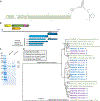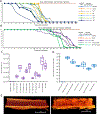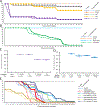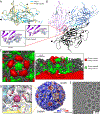Cryo-EM-based discovery of a pathogenic parvovirus causing epidemic mortality by black wasting disease in farmed beetles
- PMID: 39208798
- PMCID: PMC11781814
- DOI: 10.1016/j.cell.2024.07.053
Cryo-EM-based discovery of a pathogenic parvovirus causing epidemic mortality by black wasting disease in farmed beetles
Abstract
We use cryoelectron microscopy (cryo-EM) as a sequence- and culture-independent diagnostic tool to identify the etiological agent of an agricultural pandemic. For the past 4 years, American insect-rearing facilities have experienced a distinctive larval pathology and colony collapse of farmed Zophobas morio (superworm). By means of cryo-EM, we discovered the causative agent: a densovirus that we named Zophobas morio black wasting virus (ZmBWV). We confirmed the etiology of disease by fulfilling Koch's postulates and characterizing strains from across the United States. ZmBWV is a member of the family Parvoviridae with a 5,542 nt genome, and we describe intersubunit interactions explaining its expanded internal volume relative to human parvoviruses. Cryo-EM structures at resolutions up to 2.1 Å revealed single-strand DNA (ssDNA) ordering at the capsid inner surface pinned by base-binding pockets in the capsid inner surface. Also, we demonstrated the prophylactic potential of non-pathogenic strains to provide cross-protection in vivo.
Keywords: Zophobas morio; capsid structure; capsid-DNA interactions; cryo-EM; densovirus; diagnostic virology; emerging infectious diseases; entomology; parvovirus; superworm.
Copyright © 2024 The Authors. Published by Elsevier Inc. All rights reserved.
Conflict of interest statement
Declaration of interests Rutgers University filed US Provisional Application 63/591,484 “Method for inhibiting Z. morio black wasting disease” on behalf of J.J.P. and J.T.K. S.A.Y. is employed by REGENXBIO Inc. and holds shares in the company. J.T.K. receives a research grant from REGENXBIO Inc.
Figures






References
-
- Bishop RF, Davidson GP, Holmes IH, and Ruck BJ (1974). Detection of a New Virus By Electron Microscopy of Fæcal Extracts From Children With Acute Gastroenteritis. The Lancet. - PubMed
-
- Choo QL, Kuo G, Weiner AJ, Overby LR, Bradley DW, and Houghton M (1989). Isolation of a cDNA clone derived from a blood-borne non-A, non-B viral hepatitis genome. Science. - PubMed
MeSH terms
Substances
Grants and funding
LinkOut - more resources
Full Text Sources
Research Materials
Miscellaneous

